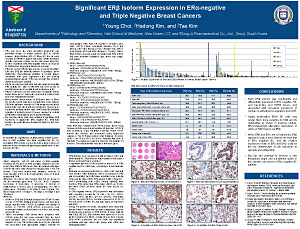Significant ERβ Isoform Expression in ERα-negative and Triple Negative Breast Cancers
1Young Choi, 3Hadong Kim, and 2Tae Kim
Departments of 1Pathology and 2Genetics, Yale School of Medicine, New Haven, CT, USA, and 3Dong-A Pharmaceutical Co., Ltd., Seoul, South Korea
BACKGROUND
ERa has been the main accepted prognostic and predictive marker of breast cancers (BC) to SERM, however, approximately 50% of ERa+ BC are de novo resistant to SERM or acquire tamoxifen (TAM) resistance despite expression of ERa. On the other hand, about 5% to 10% of patients with ERα-negative tumors do respond to TAM and the responsible factors are not clear.
ERβ, the second ERβ isotype has been recently identified. ERα and ERβ are distinctly different in genotype, tissue distribution, transcriptional activities in certain ligand, interaction with gene regulatory sites and binding pharmacological agents. ERβ has at least five isoforms (ERβ1-5) and splice variants.
ERβ is co-expressed with ERα and has shown to modulate ERα activity. The ratio of ERα:ERß has been shown to predict progression to neoplasia and malignancy in BC.
ERβ is expressed in both normal and neoplastic human breast tissue and is frequently expressed in stromal cells and in the cytoplasm/membrane.
Most previous clinical studies of ERβ were done in ERα+ BC and the results have been contradictory: some showed ERβ with favorable outcome to TAM treatment and tumor suppressive, and others with poor prognosis. Recent gene expression profiling studies have shown that ERβ probably regulates a distinct subset of genes involved in cellular proliferation and apoptosis and is anti-proliferative.
We and few others have demonstrated a significant ERβ expression in aggressive ERα negative BC. ERβ may become the potential new therapeutic target in this sub-cohort.
©2012 Yale Department of Pathology. All rights reserved.
Any redistribution or reproduction of part or all of the contents in any form is prohibited. You may not, except with express written permission of the author or the Department of Pathology, distribute or commercially exploit the content, nor may you transmit it or store it in any other website or other form of electronic retrieval system, including use for educational purposes.
